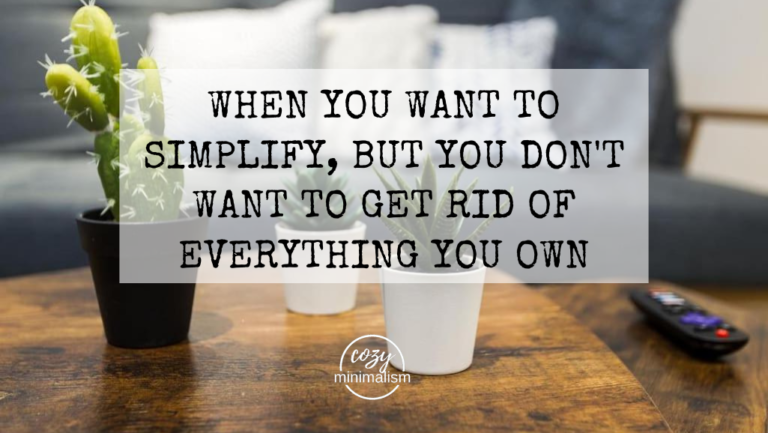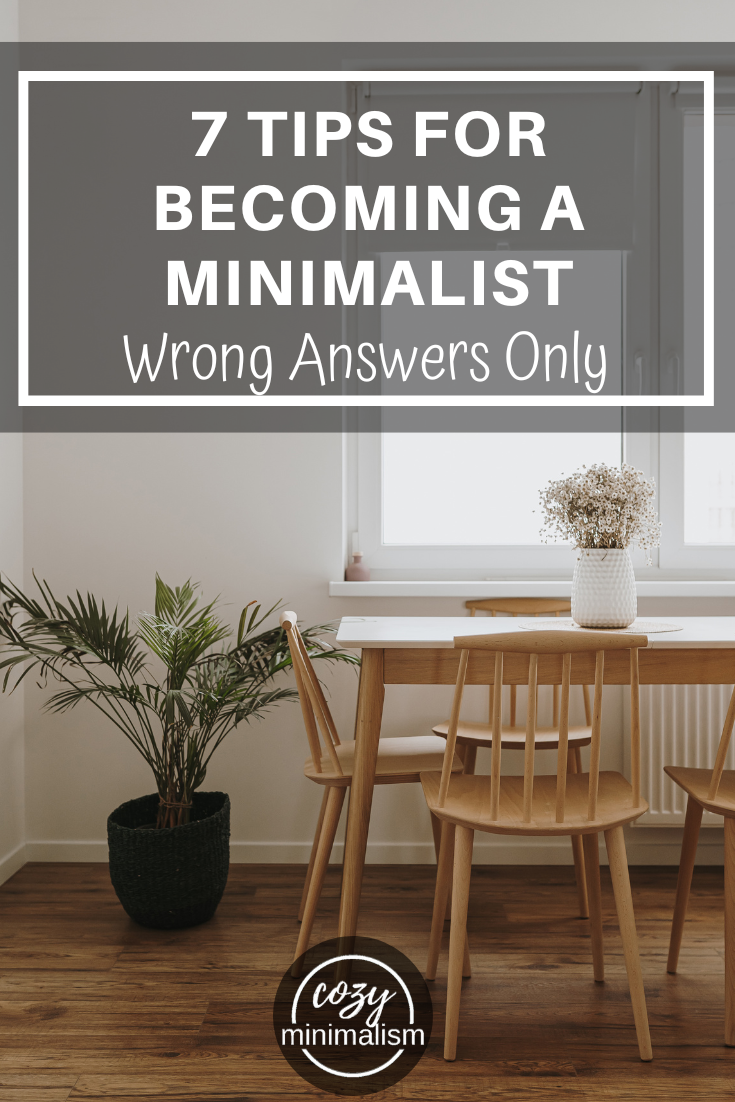

by Angie Kikstra, Founder of Cozy Minimalism
I’ve compiled some of the most common minimalism myths and misconceptions to help you discern what is good advice and what is bad advice when it comes to this new lifestyle you are embarking on.
I get it, minimalism is a popular lifestyle choice that helps people simplify their lives and achieve contentment and joy.
But, unfortunately, there are still plenty of outdated or misguided pieces of advice out there that can actually do more harm than good when it comes to getting people to become minimalists.
I created a simple path that will help people avoid these pitfalls and nail the critical minimalist mindshifts they need to achieve lasting change. It’s called The Cozy Minimalist Way. It helps you avoid these common minimalism myths.
It embodies how to find your own level of enough, and create a home that feels like home and functions well.
The Cozy Minimalist Way is firmly planted in balance, most of what I see online from misguided folks is idealism and a purist idea of what minimalism is.
So, without further ado, here’s my list of the seven worst mistakes you should definitely avoid:

This first minimalism myth has a little bit of truth in it, as long as it isn’t done to the extreme.
While it’s true that in order to become a minimalist, you need to be more mindful about your purchases, simply cutting off all purchasing altogether for a year is not necessarily the best approach.
A complete purchase ban can lead to burnout and make it difficult to truly appreciate the value of possessions over time.
I suggest a shorter timeline like a week or a month, you can learn just as much in that frame of time and you won’t start feeling like your lacking anything.
If you’ve ever been on a diet, you know the feeling.
When the diet says I can’t have something… you start craving it more.
I’m usually good for a while but then those cravings come back and I’m trying to rely on willpower alone. It just doesn’t work, my friend.
Break it down into shorter time frames so you can be successful. If a week is tough to follow through with, just commit to a day or one store visit.
You can build up from those, it’s spirit-dampening to fail. Set yourself up for success.

Minimalism myth 2 is about the common misconception that minimalism is about getting rid of everything you own or going down a checklist and only keeping things on a generic list.
It’s not a race to who can live with the least amount of stuff.
It’s about uncovering your own level of enough.
It’s ultimately up to each person to define their minimalist lifestyle, so don’t feel you have to throw out your possessions just because you think that’s what minimalism “should” look like.
What rubs me the wrong way with this thought is that a small number of people out there believe that minimalism should look a certain way. I filter nasty comments in our group daily that have to do with this. “That’s lovely, but that’s NOT minimal.” The only people who can decide what is minimal are those living in that home.
Does clutter stress you out? If yes, then that means you would totally benefit from clearing out some stuff!
You don’t have to get a dumpster and toss it all out… remove it in layers and only remove what you are ready to let go of.
Another minimalism myth is that some newbies assume they have to get completely organized before starting their minimalism journey – but organization isn’t always necessary or helpful when trying to become a minimalist!
You don’t need all those organizers and storage bins in order to succeed; what matters most is understanding the concept of letting things go in layers and getting rid of excess and that sometimes includes the organizational tools to manage more stuff.
I found that I didn’t need as much organization when I had more white space – white space is the empty space between objects in your home. Now, I have to add this caveat: I AM a big fan of containerizing my items because then my things have a boundary and it is easier to maintain. I create activity pods that can be easily put away and are easily accessible when I need the items for a specific activity (like cleaning bathrooms etc.)
Minimalism isn’t about never upgrading items.
Instead, try investing in quality products and taking care of them well so they last longer.
I lived for 6 years with an uncomfortable sofa that was shredded by my daughter’s cat.
Every time I looked at that sofa I wasn’t happy.
When I finally upgraded it (I gave it away for free to a guy that was starting over after a divorce and he was super grateful for it) my living room felt so much better.
Sometimes you have to upgrade.
Don’t live with broken, damaged and uncomfortable items just based on some idealist minimalism principle alone.
Life is too short to have a home that doesn’t fully serve you.
Many beginner minimalists find themselves in a tough spot where they’re forced into deciding between trashing an old possession with sentimental value or holding onto something they don’t really need anymore. But neither option needs to be taken if you take your time and approach decluttering mindfully – you can always follow my signature method of Gentle Decluttering!
Remember, your sentimental items aren’t clutter; prioritize storing them safely or pulling them out to be enjoyed either visually or practically in your daily use items.
Then you can focus on tackling the easier stuff. I have found that removing clutter in layers is the very best way to tackle clutter. You never feel like you are removing anything unless you are ready to let go. This leads to less regret with the whole process. This is what Gentle Decluttering is built on – removing clutter in layers.
For some minimalists, living with limited material goods also means living with limited luxuries – but this doesn’t have to be the case!
It’s completely false and even damaging to think that minimalists only have the basics. I remember a lady that chastised me on my Facebook page for having a TV!
She claimed, quite feverishly, that I wasn’t a true minimalist because I had a TV.
Uh…. no.
I actually corrected her and told her we had THREE! I didn’t need to justify our own minimal, but I feel that some of you need to hear this:
If having a TV or three connects you with your values, then you can still be a minimalist and have them. ALL of them. And that goes for anything in your home, you get to decide and justify them for yourself, not some rando on the internet or anyone else.
Some small indulgences that are aligned with what you use and enjoy allow you to have fulfillment in your life without excess quantities of stuff collecting dust in your home.
Think of this lifestyle as discernment and alignment with values rather than no luxuries.
I find that my discernment has changed over the years. At the beginning of my journey, I was ok with cheap clothing or what is commonly referred to as “fast fashion”. However, over the years, I have opted out of fast fashion and am much more selective with my purchases. A well-made, more expensive top goes further with me than an easy-to-acquire but hastily made $5 tee.
It might look like I have caved to indulgencies when you see my $50 tee when I’ve simply chosen a better-made, higher-quality product that wasn’t created by workers in sweatshops.
Another thing to consider beyond quality is what would you actually need. I don’t believe that minimalism as a lifestyle is about lack, we don’t need to live without things that would make our lives better.
I’m very intentional about what I purchase. I always say that I am quick to let go of items and slow to bring some in.
You could just throw everything out and start over, but you won’t hit those all-important Minimalist Mindshifts that are key to long-term success and sustainability with this lifestyle.
Practicing small changes throughout various aspects of your day-to-day life will help cultivate lasting habits around minimalism.
However, expecting yourself to fully commit immediately after reading one article or book on becoming a minimalist is unrealistic (and also unnecessary).
Take baby steps; start slow by simply making note of what possessions bring joy into your life versus which ones feel like burdensome obligations cluttering up space – then continue accordingly from there! Remember, little by little, a little becomes a lot!
Ultimately, minimalism is an individual journey; it’s up to each person how they want to define their own personal style of living.
Avoiding these seven mistakes will help ensure that you don’t get overwhelmed or burned out while pursuing your minimalist lifestyle.
It’s important to remember that minimalism isn’t about sacrificing all of your possessions and luxuries – it’s more so a way of life where we prioritize contentment from fewer items and strive for simplicity in our daily lives.
So if becoming a minimalist sounds like something you’d be interested in trying, start small by implementing some mindful changes into your everyday routine and get clear on what your values are and start aligning your home environment to those values. My only regret with this lifestyle was not starting sooner.

Join our thriving community so your home can be your haven!